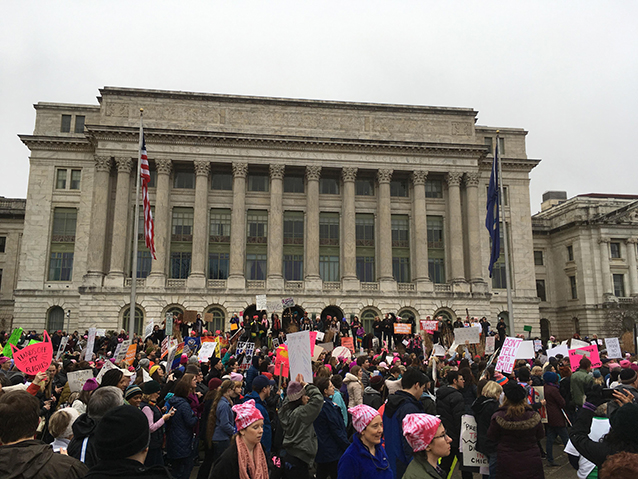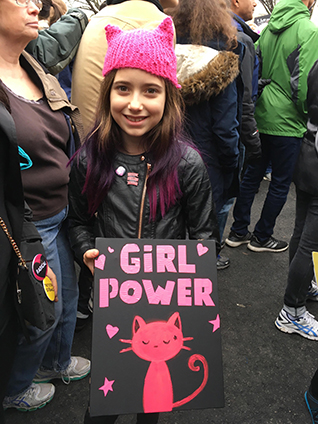by Nancy Holmstrom
January 24, 2017
I came back from the Women’s March in D.C. exhausted but thrilled, convinced that we are seeing the birth of a new women’s movement. The size, the inclusiveness, the defiant but good-humored spirit, and the progressive politics all make me very optimistic, though there will be challenges.

Photo by Nancy Holmstrom.
Let’s start with the size: having gone to demonstrations in D.C. since I was in high school, more than fifty years ago, including the 1963 March for Jobs and Freedom, numerous anti-Vietnam War demos, and the 2004 March for Women’s Lives, I think the numbers for this one were a lot more than the 500,000 estimated so far. Where we listened to the speeches the crowds were packed so tight we literally could not move. At one point we heard there was going to be no march because there were too many of us; we just filled the streets. The program lasted more than four hours, instead of the scheduled three (when will organizers ever learn?!), so late that some had to leave to catch their transportation home. So it was difficult to get a visual sense of the whole.
The demographics of the marchers were encouraging, though there is room for improvement. Overwhelmingly women (maybe 25% men–one sign said “Real Men are Allies, Not All Lies”), they were of all ages and from all over the country. Some my age carried signs saying “I can’t believe I still have to struggle for this…,” but marchers were predominantly middle aged and young, including very young girls. Most of the signs were hand-done, feisty, and many were very playful, often loaded with sexual double-entendres. LGBTQ issues and people were much more prominent than ever in the past. Although, disappointingly, the marchers were overwhelmingly white, the speakers, performers, and organizers were at least 50% women of color.
Key positive themes of the March were self-determination for women, inclusiveness, and the combination of issues as in the sign “(“I am a Muslim Mexican Undocumented Pussy with Teeth”). “Black Lives Matter” was a popular sign and chant, which felt great coming from white marchers.

Photo by Nancy Holmstrom.
Initially I was unenthused about having the only big march planned around Trump’s inauguration being a specifically women’s march, as there are so many issues to protest, and because I thought it would be just a liberal Hillary event. But other issues were connected to women’s issues–and this will be key in the next period. There was a Women for Climate Justice contingent, (some) anti-war, and a lot of race/criminal justice issues raised, and many others. Certainly many marchers and speakers were liberal. But the political reality is that many basic liberal gains are threatened by the rise of the Right and socialists need to be there in the struggles, pushing beyond reliance on the Democratic Party. As Tamika Mallory, a young black woman who was one of the National Co-Chairs said, “you’re scared now, well this has always been our reality forever,” under Clinton and even Obama.
Many of the speakers were very radical and militant, although mostly around race and gender issues. They included rape survivors, queer and trans women, a formerly incarcerated woman, black women elected officials, and others, including adorable six year old Sophie Cruz who said we were “building a chain of love to protect our families” from deportation. Many (including Madonna!) used the word “Revolution,” usually explained as a Revolution of Love. Angela Davis, unsurprisingly, was the most radical.
This new women’s movement that seems to be emerging will be mixed ideologically, just like the March. The Guiding Vision and Definition of Principles at the Women’s March Website are quite good, though they could be better. They start with statements about Human Rights and Women’s Rights, then “Gender justice is Racial Justice is Economic Justice,” but were weakest on the latter. They call for an “economy powered by transparency, accountability, security and equity… workforce opportunities that reduce discrimination…” the right to “organize for a living wage,” but no mention of the $15 minimum wage or“equal pay for equal work.” (The two union speakers were Ai Jen Poo of the Domestic Workers Alliance and Randi Weingarten of the American Federation of Teachers.)
But how could we expect otherwise? We are far from a mass socialist movement. At least, thanks to Occupy, Black Lives Matter, and the Sanders campaign, issues of economic and racial justice are on the agenda. When the Republicans repeal the Affordable Care Act, and have nothing better to replace it, many of Trump’s followers will be surprised and disappointed. This will give us an opening to raise the demand for Single Payer, stressing how it is a women’s issue and a racial issue, pushing the liberals in the new women’s movement to extend their call for “reproductive health care for all” to simply “health care for all.”
Mainstream feminists today have moved far to the right of the Women’s Liberation movement of the 1970s. However, a more radical politics is implicit in manyWomen’s March principles and socialists should be prepared to expose the contradictions and draw out their more radical alternatives. Ecological issues will only become more pressing, and we have to push beyond “Protect Mother Earth” to their anti-capitalist implications.
As speaker after speaker said, this is only the beginning. Resistance is on the agenda.
Nancy Holmstrom is Professor Emeritus of Philosophy at Rutgers University, editor of The Socialist Feminist Project (Monthly Review Press), co-author of Capitalism For and Against: A Feminist Debate (Cambridge University Press) and a socialist feminist activist.

Comments
One response to “Women’s March 2017: The Birth of a New Women’s Movement?”
Researching The Women’s Movement for and Annotated bibliography for my Research Method Cclass, all material available will help.Hope to see you again in January.